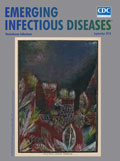
Volume 24, Number 9—September 2018
Etymologia
Etymologia: Granulicatella
In 1961, Frenkel and Hirsch described strains of streptococci isolated from cases of bacterial endocarditis that grew only in the presence of other bacteria, around which they formed satellite colonies, or in media enriched with sulfhydryl compounds, such as cysteine. These nutritionally variant streptococci were eventually assigned the species Streptococcus defectivus (Latin for “deficient”) and S. adjacens (because it grows adjacent to other bacteria).
On the basis of later research, these were placed in a new genus Abiotrophia (Greek a, “un-,” + bios, “life,” + trophe, “nutrition”) as A. adiacens and A. defectiva. In 1998 and 1999, 2 additional species of Abiotrophia were described, A. elegans (Latin, “fastidious,” referring to fastidious growth requirements) and A. balaenopterae (isolated from a minke whale [Balaenoptera acutorostrata]). In 2000, these new species, along with A. adiacens, were reclassified in the new genus Granulicatella (Latin granulum, “small grain,” + catella, “small chain”).
References
- Bouvet A, Grimont F, Grimont PA. Streptococcus defectivus sp. nov. and Streptococcus adjacens sp. nov., nutritionally variant streptococci from human clinical specimens. Int J Syst Bacteriol. 1989;39:290–4. DOI
- Roggenkamp A, Abele-Horn M, Trebesius KH, Tretter U, Autenrieth IB, Heesemann J. Abiotrophia elegans sp. nov., a possible pathogen in patients with culture-negative endocarditis. J Clin Microbiol. 1998;36:100–4.https://www.ncbi.nlm.nih.gov/entrez/query.fcgi?cmd=Retrieve&db=PubMed&list_uids=9431929&dopt=Abstract
Original Publication Date: 7/31/2018






















.png)











No hay comentarios:
Publicar un comentario